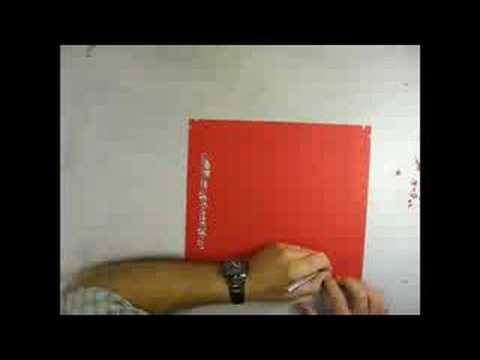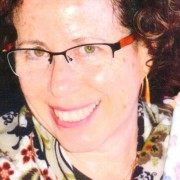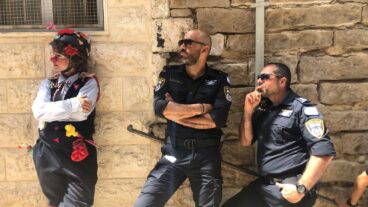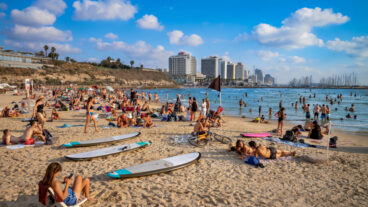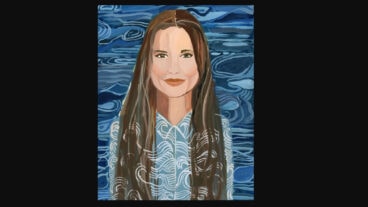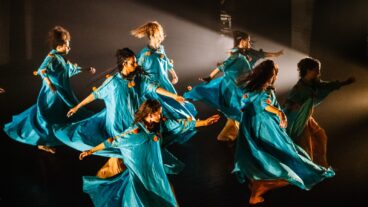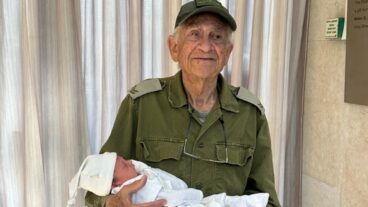The last day of August marks the end of a 10-year odyssey for paper-cut artist Archie Granot. That’s the closing date for his exhibition, The Papercut Haggadah, a one-of-a-kind, 55-page project started a decade ago when Granot was commissioned by patrons to cut, clip and create a new version of the traditional Jewish Passover holiday text – a fitting task for a contemporary abstract artist working in a traditional Jewish folk art form.
“I think that I stand very firmly in two worlds,” Granot tells ISRAEL21c. “My work is contemporary but also within a tradition of Jewish art. The way I do paper-cutting isn’t traditional, so I think I’ve taken a folk art and transported it to another level.”
Like so many artists, Granot didn’t choose his medium – it chose him. He was born in London and moved to Israel to live on a kibbutz in 1967, then went on to earn degrees in Political Science and Russian studies from Hebrew University and University of Glasgow, Scotland. He discovered paper-cutting in 1979, when his daughter came home from school with a paper-cut image she had made. Intrigued, Granot began to pay attention to the paper-cuts on display in the Judaica section of the Israel Museum and finally decided to give it a try.
“On a basic level this is a very simple art,” Granot says. “You fold a piece of paper, cut it, and when you open it up you have a symmetrical design. There are paper-cuts all over the world.”
A master of the scalpel
Paper-cutting has its roots in China where mass produced paper was invented and the tradition was likely imported Westwards via the silk trade routes. It became popular within Jewish communities very early on – there is a reference in a Hebrew essay from the year 1345 entitled “The War of the Pen Against the Scissors”. The medium was readily available, inexpensive and could easily incorporate images of animals, plants, Hebrew inscriptions, religious and mystical symbols. It could also be practiced by men and women alike – all that it required was a sharp knife, a steady hand, imagination, time and patience.
Granot himself is a master of the scalpel. “When I started, l remembered the dissection blades I’d used in biology in high school. A regular Exacto knife wasn’t good enough so I started using surgical blades and I’ve been using them ever since,” he explains. Working out of his gallery-studio in Jerusalem, he leans over a cutting board set on a table adjusted precisely to his working needs (“a comfortable seat and an excellent light are also really important”), using and discarding blade after blade to cut and place layer upon layer of paper in varying colors. The resulting multi-level pieces can be 2-2.5 cm. thick and can weigh over 3 kilos.
The paper-cutting process requires painstaking attention to detail and designs must be planned out in advance, though Granot says there is room for improvisation. “The nitty gritty is that when I sketch a work, I really know how it’s going to look at the end. But as I work, it changes. I’m working on a private commission right now and I was actually inspired by the shadow I saw on a very badly built wall. The shadow came out well but something was bugging me last night. I realized what it was – I had thought I was going to use certain colors that are a little bit difficult in combination – I worked all morning on changing it and now I have it.”
Granot uses acid-free paper that must also be free of fibers that can quickly dull a blade. “Whenever I go somewhere I look for paper. It’s a never ending escapade. I use papers that are made in France, Germany, Denmark, Spain, Italy, Japan, Czech Republic, the US, Canada, and I have one work that was done on straw paper made by a papermaker here in Israel.” He sets aside one day a month for weaving deckle-edged paper, another element in his work – “it’s very long and exhausting for the wrists”.
He also hand-cuts gold leaf, a process he describes as “excruciatingly difficult. The cut has to be very clean and no matter how thin the leaf, gold is a metal and dulls the blade. So you have to change blades every few minutes.”
In general, Granot doesn’t use laser – “It doesn’t give me that same sense of artistic achievement” – though he has used the medium to create some limited editions.
Inspired by sacred verses
Like his predecessors, Granot’s work incorporates traditional symbols used in Jewish paper-cut folk art for centuries, but he has created his own visual language: a blend of Hebrew calligraphy and abstract geometric shapes and patterns – all inspired by sacred verses and biblical tales.
“I’m very drawn to Jewish texts and they have a meaning for me on an existential level, a literary level and a religious level. I’m not a kabbalist, I’m a regular guy, but I do think esthetics and spirituality go together.”
According to his website, Granot’s Haggadah “was crafted with the goal of evoking the intense emotions attached with the Passover Seder by utilizing geometric and abstract shapes instead of the usual symbols… Each page tackles a certain aspect or song associated with the Seder…” So it’s no accident that some pages are reminiscent of the Pyramids of Egypt, the waves of the Red Sea, or the hypnotic repeating pattern found in every piece of matzah.
A self-described “monomaniac” about his work, Granot laughs that he doesn’t see whole objects anymore, only color and design. “My kids laugh at me – I cut open a kiwi and it gives me a feeling of humility that I haven’t yet achieved the perfection of the spread of seeds within the fruit. And I’m thinking of shapes the whole time.”
Granot has exhibited in the US, Israel, France, Germany and Japan and his works are part of collections at Bar Ilan University, Hebrew University of Jerusalem, the Israel Museum, and the Jerusalem Great Synagogue; Museum der Scherenschnitte, Vreden, Germany; Victoria and Albert Museum, London, England; Jewish Museum, New York; Jewish Theological Seminary, New York; Yeshiva University Museum, New York; Philadelphia Museum of Judaica, Philadelphia; and other museums, public and private collections. Granot’s work was recently featured in “Ombres & Lumières,” Musée des Miniatures et Décors de Cinéma, Lyons, France.
The Papercut Haggadah by Archie Granot is on display at Yeshiva University Museum in New York City, till August 31, and a facsimile edition is in the planning stage. Two other works, Mezuzah and Shalom, are on exhibit in Chicago at the 5th International Book & Paper Arts Triennial till September 12.




